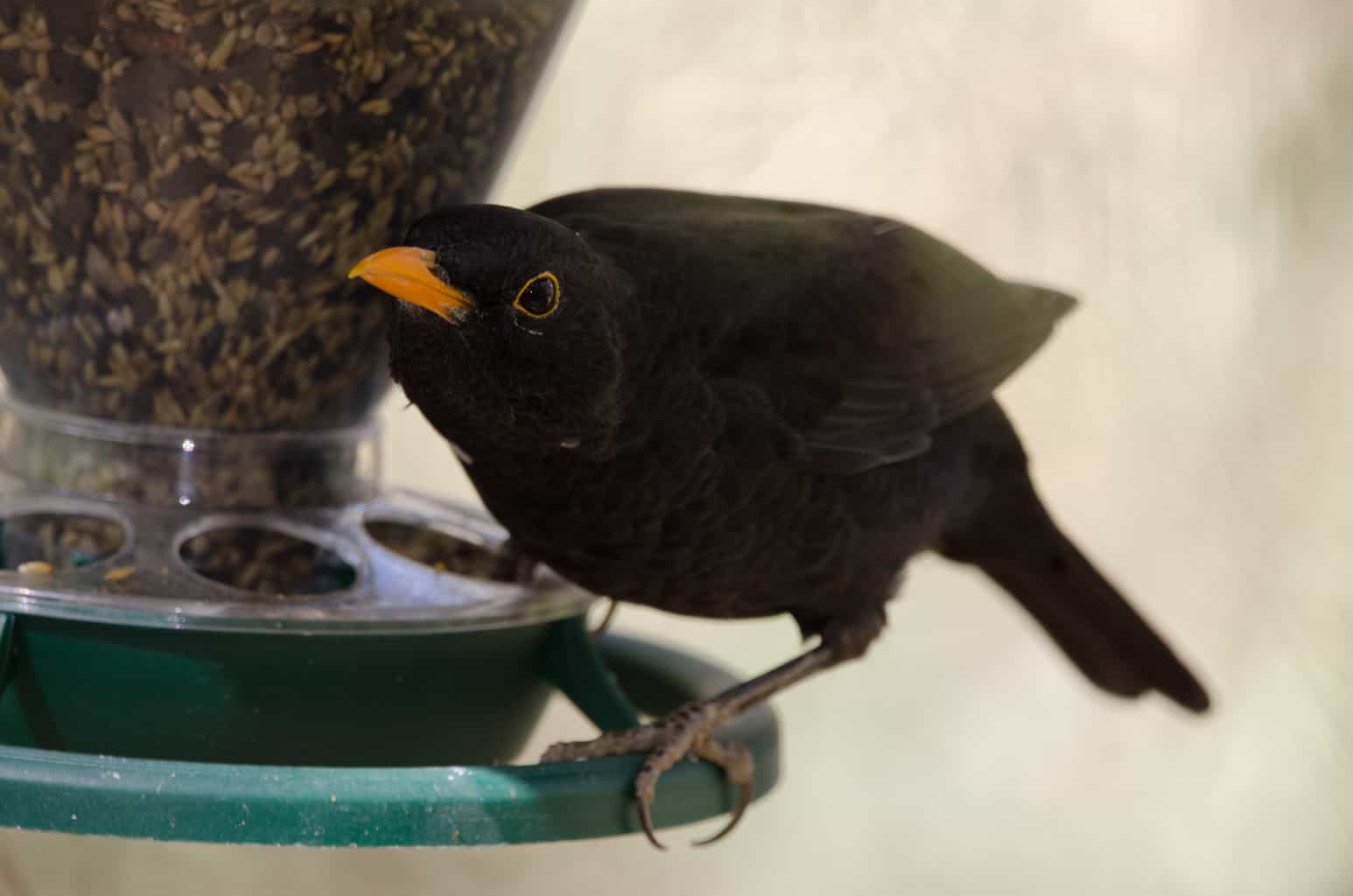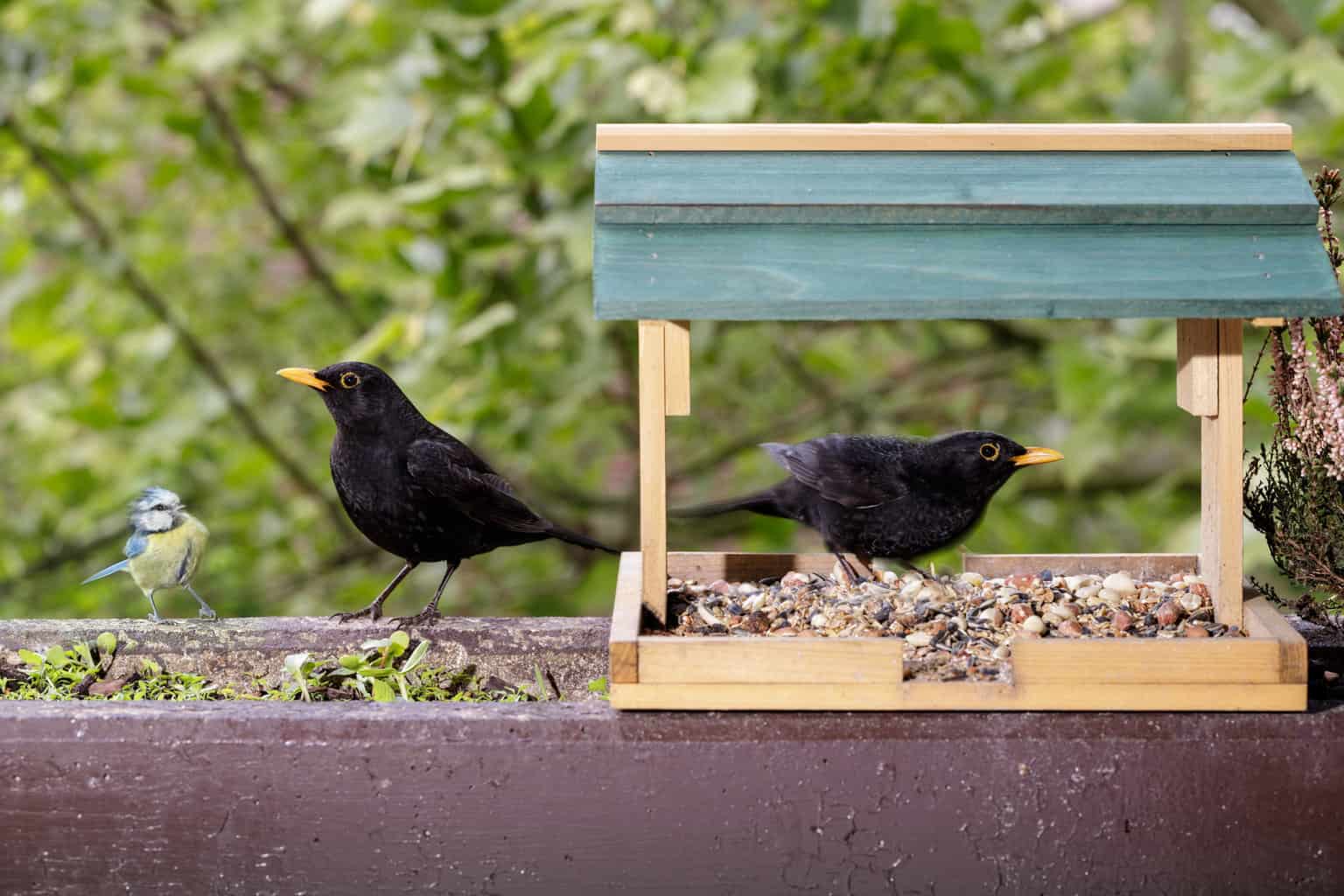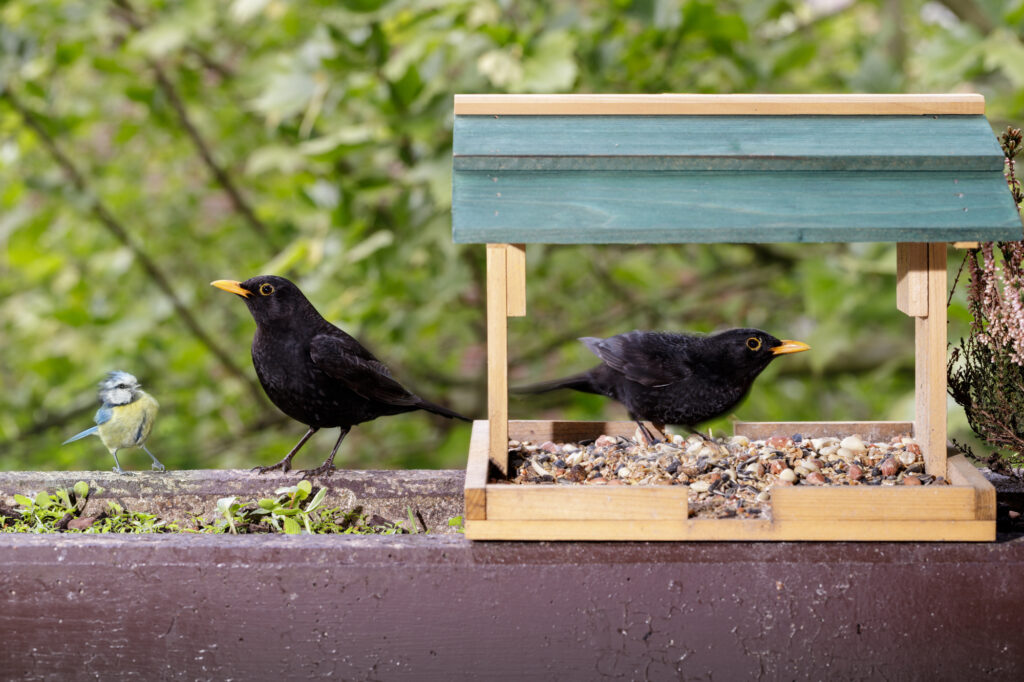It’s a backyard problem that many backyard birders are familiar with: blackbirds and starlings taking over a feeder.
Starlings and blackbirds such as grackles and cowbirds are what some people call “bully birds.”
It’s not that they are intentionally bullying other birds, but certain species are just more aggressive at backyard feeders. It’s how they survive.
Some people don’t mind feeding these types of birds. After all, it’s just their nature. Other bird watchers, however, prefer not to subsidize these birds, especially since they keep other birds away from their feeders.
How Can You Prevent Birds Like Starlings and Blackbirds From Taking Over?

Hang feeders with adjustable perches that are triggered by weight. When a heavier bird lands on it, the perch drops down and locks the seed port from being accessed. The perches can be adjusted to the weight of the bird you want to exclude. The Squirrel Buster and the Yankee Flipper are the most effective feeders of this style, in my experience.
- Made in the USA
- A favorite seed of Cardinals and other songbirds
- Highest quality grains used
Last update on 2024-04-19 / Affiliate links / Images from Amazon Product Advertising API
Clean out your feeders well and then fill them with safflower seed only. Some birds love safflower, including cardinals, chickadees, and nuthatches, but most don’t, including starlings and some blackbirds.
According to Wild Birds Unlimited’s Springfield, Illinois store, starlings have a hard time cracking safflower seeds. As well, larger birds like grackles that can crack the seeds don’t like the bitter taste.
If you replace your bird seed with safflower and keep it that way for two or three weeks, hopefully, you’ll start to see results.
Also, as a bonus, some people say that squirrels don’t care for safflower. Others say that squirrels have started to develop a taste for bitter seeds.
Use tube feeders that Starlings and Blackbirds can’t sit on. You could put up two or three feeders offering sunflower seeds, thistle (Nyjer) seeds, and peanuts in the shell.
Just make sure the perches are short enough–one inch to an inch and a half long–so that small birds can still use them but the larger birds can’t.
In-shell peanut feeders will be successful in leaving out the starlings, as they aren’t strong enough to crack the shells.
“Bully” birds can be Blue Jays, House Sparrows, Grackles, Pigeons & Cowbirds, not just Starlings & Blackbirds.
Stop filling your feeders that the bully birds are visiting for two to three weeks and hopefully they will move on to another location. The potential drawback to this is that you will lose the birds you want to see for a while too.
Hopefully, they will return in time, while the blackbirds and starlings stay away.
Hang a dome baffle over the top of a suet feeder. Starlings are reluctant to go in tight spaces such as this one and likely won’t bother with this feeder while it’s under a baffle.
How to Leave Out Starlings and Blackbirds at Your Feeding Station
- If you have a variety of feeders that blackbirds can’t eat from easily, they may become discouraged and leave your yard in search of an easier meal. Be selective in what feeders you use and only target the birds you want to see.
- Avoid mixed seed bags that include milo. Blackbirds like milo, while other birds do not care for it.
- Use tube feeders for finches with only thistle seed in them. A special thistle feeder has very small seed ports made especially for this tiny seed.
- There are also a variety of feeders for black-oil sunflower seeds that are “clinging” feeders. These are intended for birds that can cling to the surface. Among these birds are woodpeckers, chickadees, nuthatches, and finches. Blackbirds and starlings find these types of feeders more difficult to navigate.
- Fill a very clean hopper feeder with safflower seed only. Even the slightest smell of peanuts or black-oil sunflower will draw the birds you don’t want. The cardinals, chickadees, and nuthatches will love it.
- Hang any type of feeder in a cage with openings only small birds like chickadees, titmice, and finches can fit through. Large woodpeckers that you want to see are still able to reach suet, even when in a cage feeder, by using their long beaks and tongues.
- An upside-down suet feeder will be harder for starlings and blackbirds to eat from, but woodpeckers and nuthatches will manage it easily. In my experience, blackbirds have no problem gobbling up the suet from this feeder, but it does slow the starlings down.
- Spread your feeders out rather than clustering all of them together. You will want to keep the feeders that successfully deter blackbirds and starlings in one location as a bird feeding station. After, move the others far enough away, each by themselves, out of sight from one another if possible. This strategy is for feeders that the bully birds can manage, or for platform or table-style feeders that you want to allow them to feed from.
With a carefully planned strategy, you can achieve tranquility at your bird feeders without the bully birds like starlings and blackbirds dominating the show.
A Selection of Feeders for Detering Starlings & Blackbirds

These are my top recommendations for caged bird feeders that will keep “bully birds” out:
Variety of Caged Feeders Here
Thistle seed and mixed finch seed (finches love mixed seed too, but maybe not quite as much as plain thistle seed.)
Pests at Bird Feeders Understanding all the pests that come to bird feeders and birdhouses are essential before you find success at controlling them.
- Top Killer of Wild Birds Cats is the leading cause of bird deaths in North America. Pets and feral cats are responsible for billions of wild bird deaths each year.
- Number Two Killer of Wild Birds: Windows The windows in our homes are a problem, as most of us know. There are solutions.
- Backyard Predators There are other animals that prey on our songbirds in our backyards. Learn what they are so you can help.
- Bullies: Starlings & Blackbirds The starlings and blackbirds are taking over my feeders. What can I do?
- Nectar Feeder Problems Learn how to solve the problems that feeding nectar to backyard birds brings.
- Where are they in winter? It can happen any time of year. The birds you were happily feeding all of sudden disappear. What can be done?
- Bird feeding can be messy There are multiple solutions. Learn about them here.
- Birds Striking Aircraft This can be a serious issue.
- Plan to Win With Squirrels Lots of help here for winning the bird feeder war against squirrels.
- Bird Feeding Problems Sometimes it seems like there are a lot of problems to overcome when feeding birds in your outdoor space. Find the answers.
Are Rats Your Problem?
- Rodent Control of RatsThis situation calls for strategic and timely action. Learn the steps to effective rat control.

